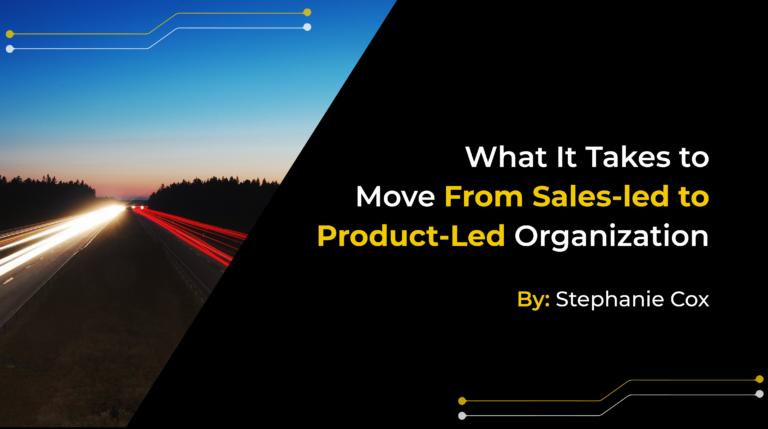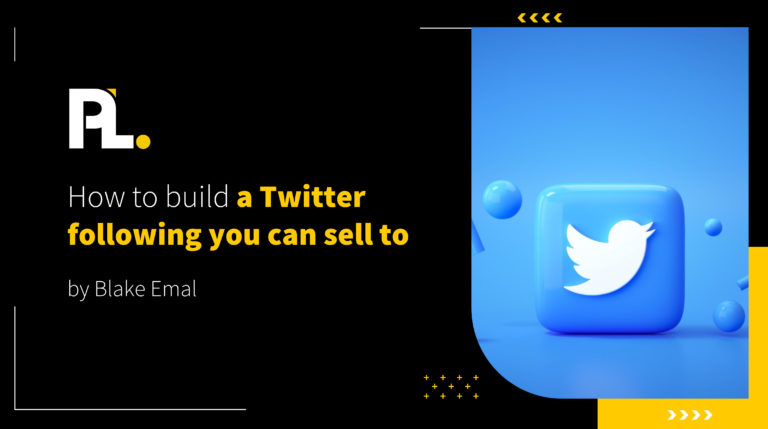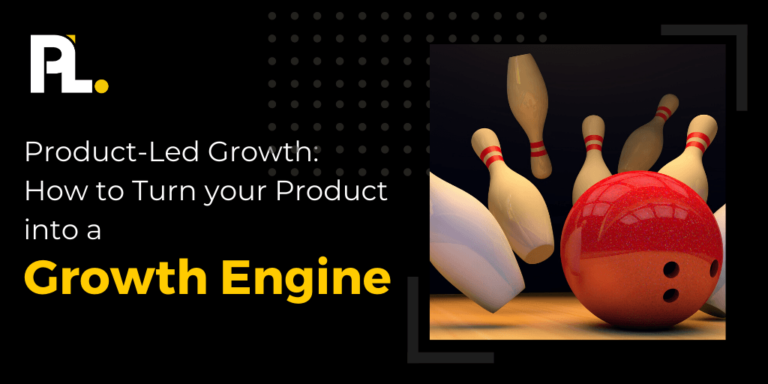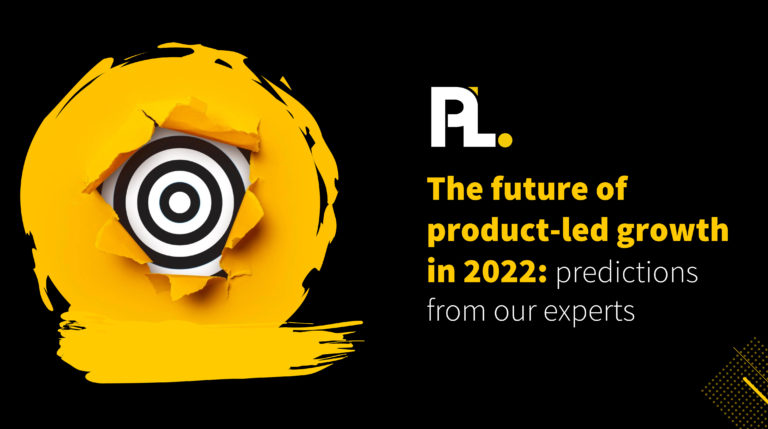Product Qualified Leads (PQLs) are still a relatively new concept. Just to be sure we’re all on the same page, the definition of a PQL I’ll be using is: a potential customer that is likely to convert to a paid customer, provided they achieve some initial value from your free offering.
If you aren’t tracking PQLs or aren’t sure why you would, I have to ask…
How can you NOT care about PQLs?
In the new world of SaaS, PQLs are the only way we can reliably measure new opportunities.
To watch the video on this topic, hit play below or read on for more...
Out with the old, in with the new

The old world of software was sales-led. A lead would contact the company, speak to someone on the sales team, go through some QC checks, arrange a demo, and maybe a face-to-face meeting... You couldn’t buy without talking to a salesperson.
The new world is product-led. If you have a credit card and an internet connection, you can go out and buy any software you want. The funnel has changed, sales teams are much more selective now and don’t get involved until much later. The new world is built on try-before-you-buy. Your product is your sales team.
Whether it’s through a free trial, a freemium model, or a proof-of-concept demo, nobody buys software these days without trying before buying.
If your sales are driven by your product, failing to qualify them based on product usage means you are operating in a way that is counter to your business model.
Why would you get people to use your product and then not measure how they use it?
The Why and How of Product Qualified Leads
Why should you use PQLs?
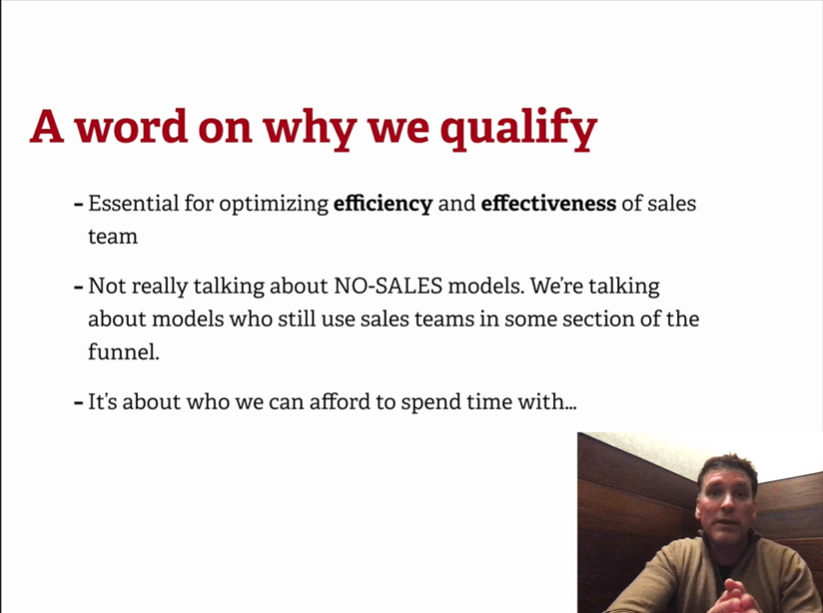
PQLs are essential if you want to optimize the efficiency and effectiveness of your sales team. Time is money and nobody knows that more than sales teams. Using PQLs means you’re able to work out who you can afford to spend time with.
With a solid PQL framework in place, you can determine the point in your customers’ journey at which it is actually worth your resources to start communicating with and selling to them.
How do you use Product Qualified Leads?
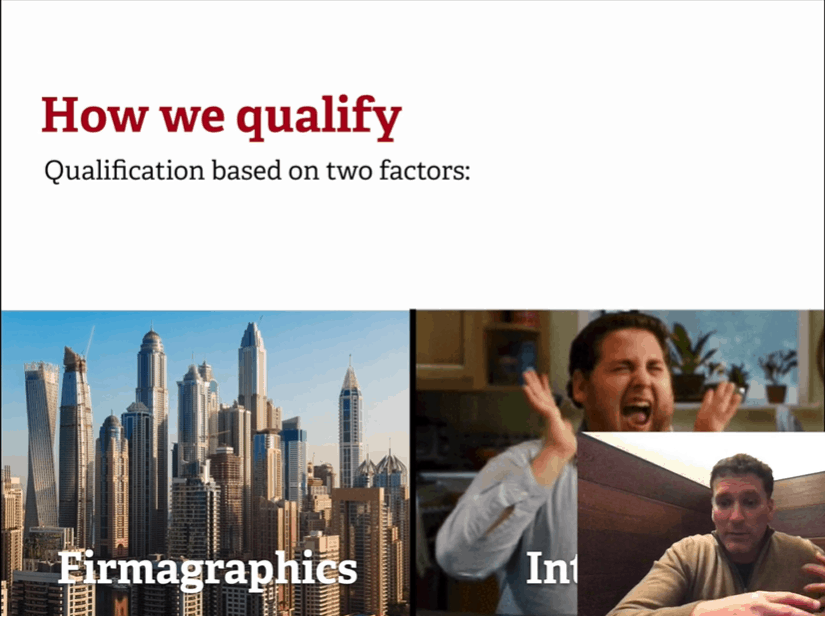
The best PQL models are based on two factors – firmagraphics and interest.
Firmagraphics match your leads to your target customer profile (size of company, industry, location, integrations, roles). These are how you qualify the account/firm you’re selling into. It’s a very traditional model that has existed in plenty of older sales strategies.
Measuring interest from PQLs is far different from a traditional model. In the old world, we tracked prospects’ interest through website visits, page visits, downloads, and demo signups. In the new world, we track how they are using your product.
That’s it.
Organic interest is as simple as asking: are they using it?
If you want to really push the limits, you can ask a second question: are they still using it?
Measuring interest
Okay, I’m being a little facetious there. Interest is best measured by two metrics: hand-raising and organic engagement.
Hand-raising is more common in freemium products. This means locking off features and leaving an ‘unlock’ button or easy interest signal that takes the user to your sales team so that they can access that (or those) paid feature(s).
Organic engagement is best measured in free trial models and means tracking the engagement of all trial at the account level to create a baseline and then measuring activation rate.
Activation rate is where PQL really comes into its own and should be the cornerstone of your PQL framework. Let’s dive into it more.
Measuring activation rate
Let’s get a few definitions cleared up first.
Activation is the “aha” moment that your customer has after a series of actions. The point where they have passed through all the gates you opened for them and picked up all the breadcrumbs.
Activation rate is a measure of how far along that account is towards their aha moment.
At Sherlock, we believe that SaaS companies are making a huge mistake when they treat activation as a binary.
Your users are not either “activated” or “not activated”. They are all on a path and you need to understand how far along each account is on that path, as there are different interventions you can make to move them on for each step.
For example, a Gmail customer journey might look something like:
1 – Account sign up
2 – Connects to GSuite
3 – Create first template
4 – Send 5 emails
5 – View report 2 times
6 – Invites 2 teammates
7 – Activation!
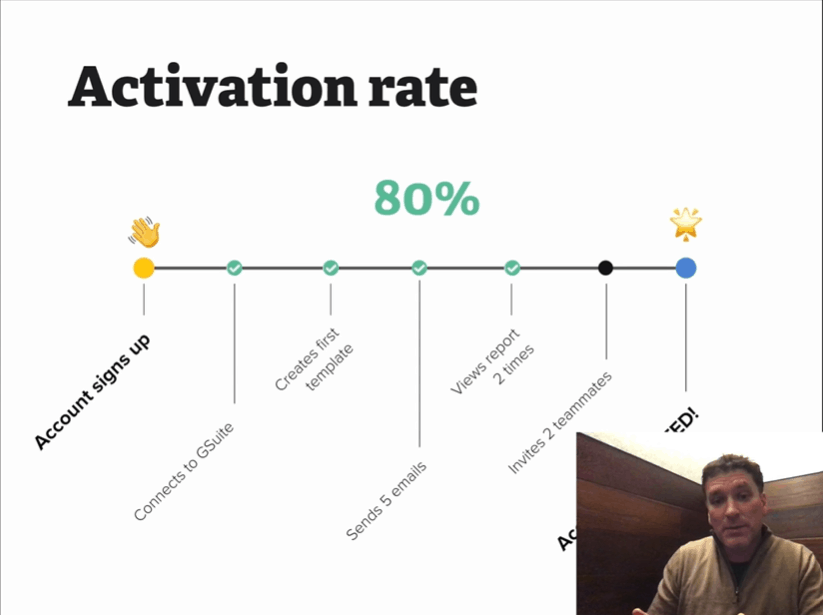
If they’ve taken two of those steps, they’re considered 20% there. If they’ve done 5, they’re considered 80% there.
Once an account has reached a certain activation rate, you can consider them a PQL.
So, what activation rate should you use to classify a prospect as a PQL? There are two questions we need to ask before we can say…
Building your Product Qualified Leads framework
Those two questions are:
- How complex is your product?
- What is the size of the opportunity from your lead?
The more complex your product, the earlier your team need to get involved.
The bigger the opportunity, the earlier you can afford to get your team involved.
For a simple product, 70%+ of trials may be able to self-serve themselves to value and activation.
For an intermediate product, ~50% of trials may be able to self-serve themselves to value and activation.
For a complex product, <25% of trials may be able to self-serve themselves to value and activation.
Putting all of this together creates this framework:
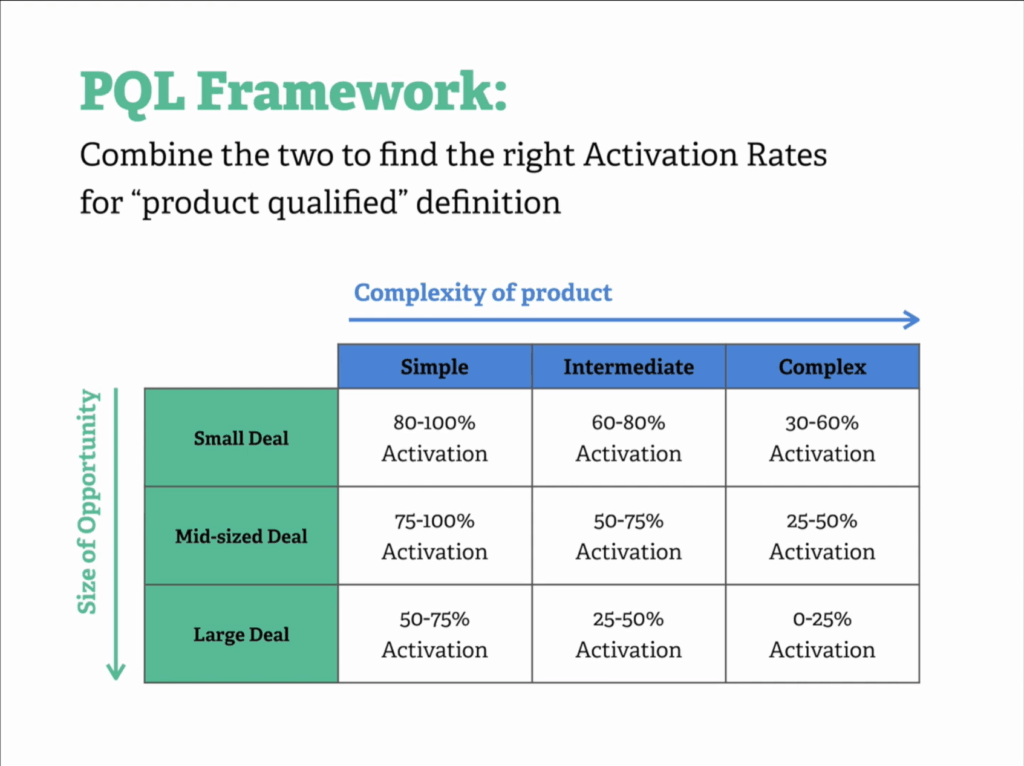
Use the framework to work out how and when to get your team involved, to work out where in the activation journey you can get your team involved.
A note on the PQL framework:
It is hard to predict deal sizes as small, mid-sized, or large with high accuracy, but PQL is not a rigid framework. It is designed to flexible and transparent so as to provide trustworthy signals to your team so that they can make informed decisions.
How to engage with your Product Qualified Leads
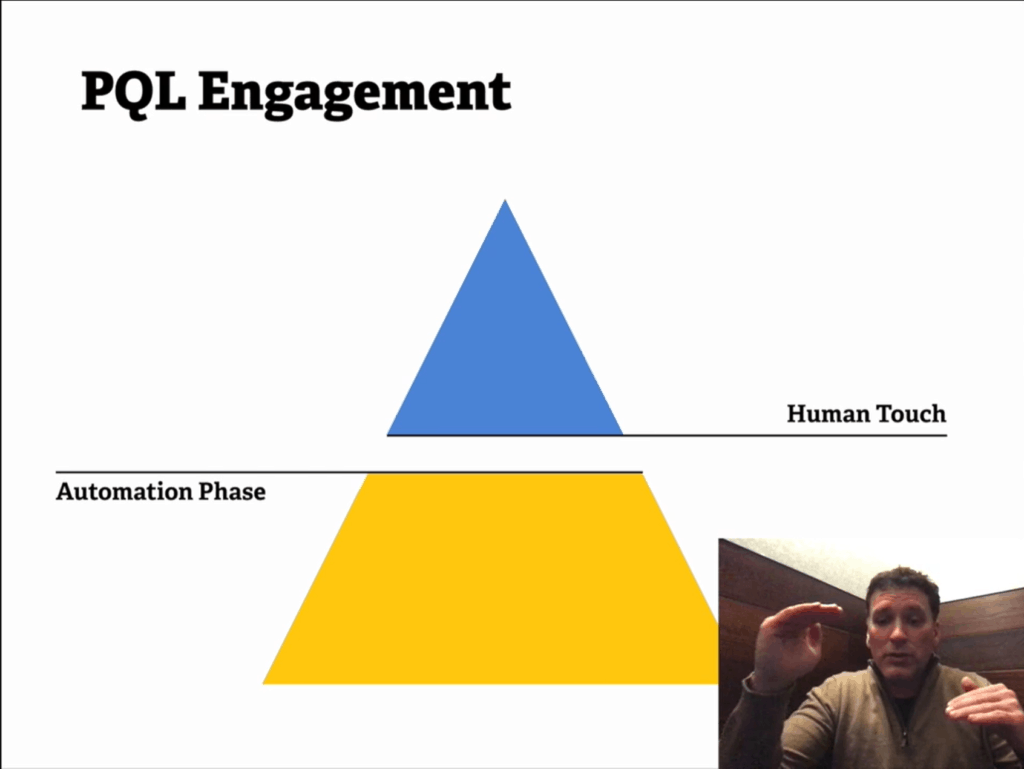
PQL engagement strategies are best divided into two phases: the automation phase and the human touch phase.
Automation phase at the start looks like in-app onboarding, onboarding emails, your help center, and videos.
Human touch looks like calls, demos, and onboarding/implementation support.
What separates these two phases is the PQL status based on activation rates. For example, if you determine your PQLs as leads who have passed 80% activation rate, that’s the point at which you begin the human touch phase.
Product Qualified Leads across the customer lifecycle
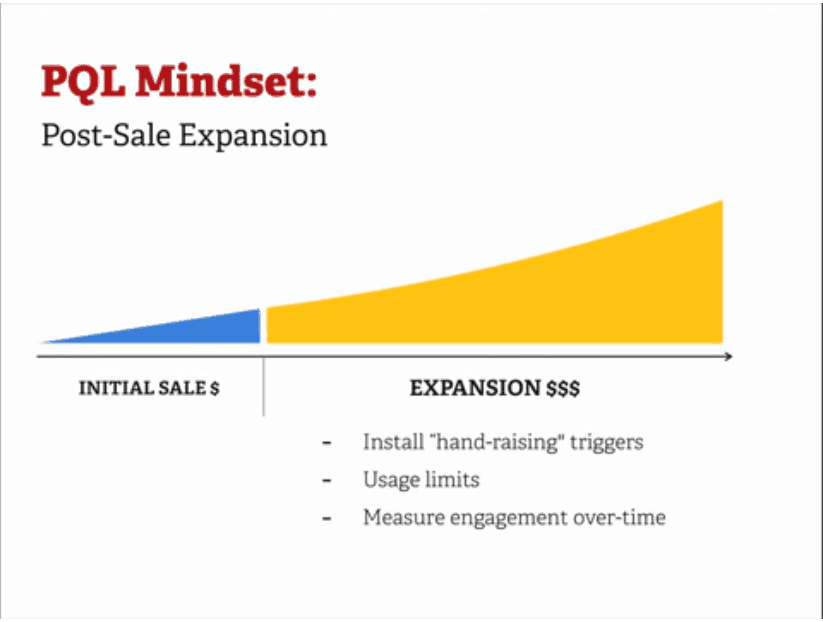
Here’s a gold nugget for you… PQLs don’t just exist at initial conversion stage! Year-on-year, expansion revenue is becoming a bigger percentage of overall new revenue for SaaS companies.
As a result, you really need to adopt PQL across your company. Customer Support need to know about it, Account Management need to know about it, Product need to know about it.
You can build PQL models into your full customer lifecycle by adding hand-raising triggers in your product (such as new features that need unlocking), usage limits (x number of tracked event, number of seats available, anything!), and measuring engagement over time (if a customer is getting massive use out of their current tier of product or have suddenly spike their usage, they may be ready for an upgrade).
Product Qualified Leads are a unifying metric
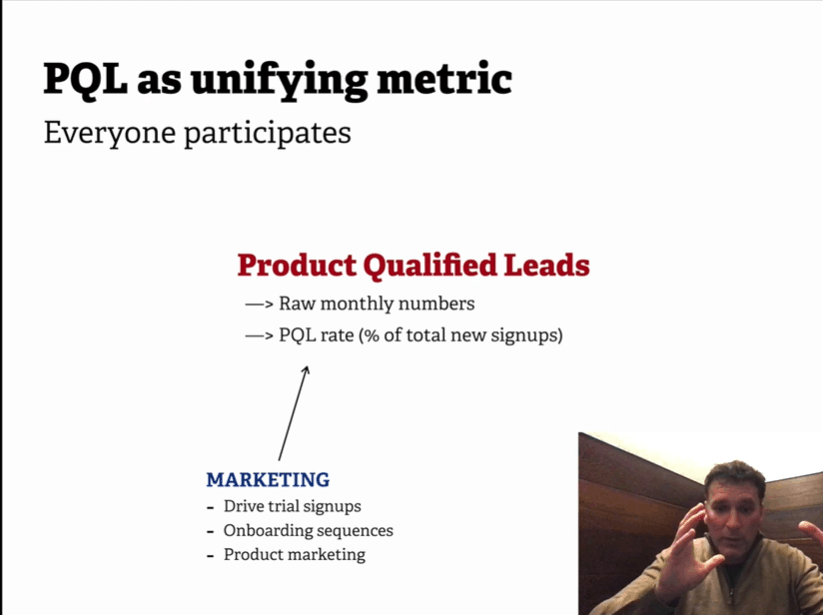
Hopefully the engagement and customer lifecycle perspectives have shown you why a PQL model is a silo-breaking metric. So many teams can rally around it, as everyone participates directly towards its success and operation.
Look at your raw monthly PQL generation numbers (20 PQLs in January, 25 in February, etc.) as a great overarching metric for the company.
Another great choice is your PQL rate (% of total new signups in a period that reached PQL status – e.g. 100 signups and 20 of them became PQLs = 20% PQL rate).
It should be clear how so many teams are involved in this:
Product has a huge stake in this, as they need to build a great product with smart onboarding to improve PQL.
Marketing has to drive trial signups, perfect onboarding sequences, and hone product marketing. Just because somebody has signed up for a trial, doesn’t mean marketing’s job is done. It carries on inside the product and throughout the customer lifecycle.
Customer Service has to be on top form with an up-to-date, in-depth support library and world class in-trial support.
PQL means no more silos and a lot more unity.
Product Qualified Leads in six steps
We’ve been through a lot in this post, so let’s summarize things real quick.
- Try-before-you-buy model necessitates qualifying leads based on product usage
- Product engagement and activation = best measures for interest
- Track and use Activation Rate as the key metric for PQLs
- Design your PQL framework around the complexity of your product and the size of leads
- Bring PQL mentality to post-sale, expansion areas of your funnel
- Rally your team around PQLs
Check out our free eBook if you want to go into more detail on how you can determine and create your PQL framework.



